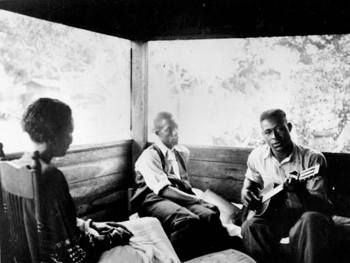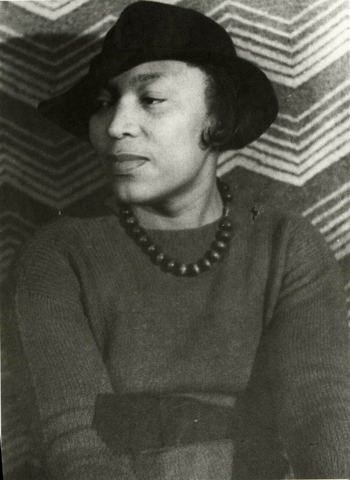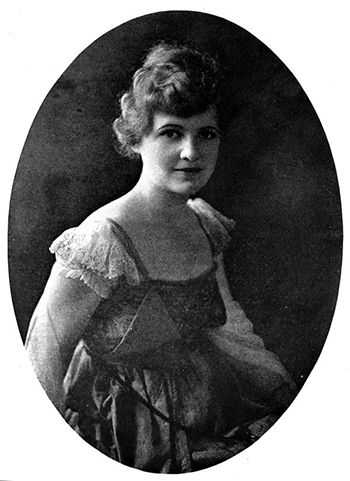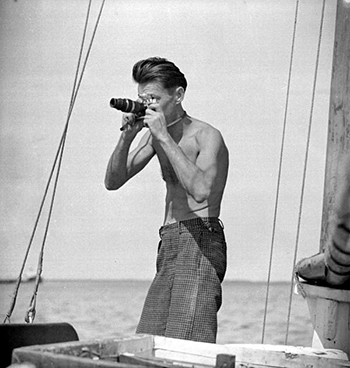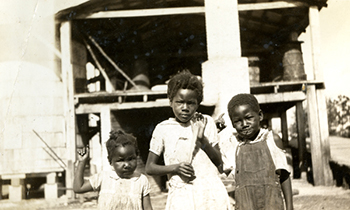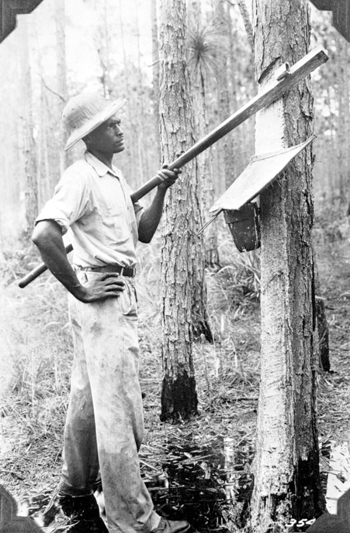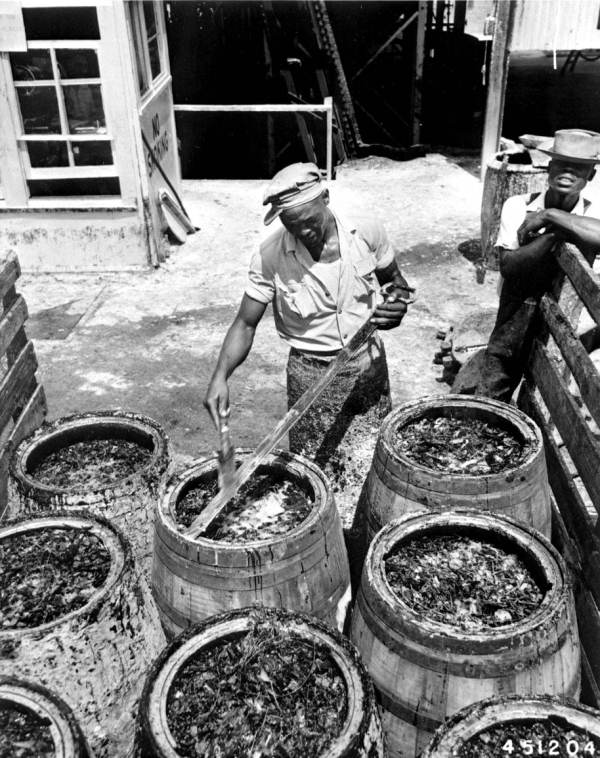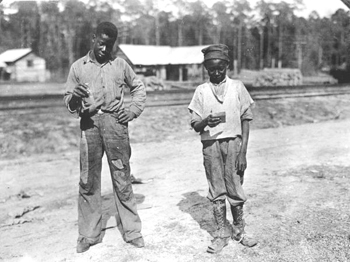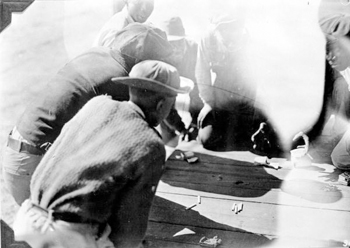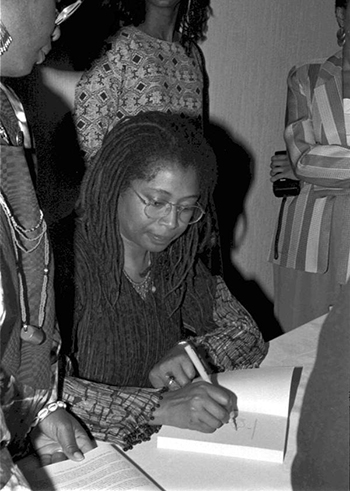Zora Neale Hurston and the WPA in Florida
Photos and History
Anthropologist, Folklorist and Author
Zora Neale Hurston was an accomplished anthropologist, folklorist and author. By 1938, she had already published Jonah’s Gourd Vine, Mules and Men and Their Eyes Were Watching God. Hurston earned two prestigious Guggenheim grants, and her novels received significant attention in the top literary circles of New York and elsewhere. Her work captured the stories, songs, traditions and histories of African-Americans in small communities across Florida.
Zora Neale Hurston and Rochelle French listen to Gabriel Brown playing guitar: Eatonville, Florida (1935)
Image number: FA0514
In 1935, Hurston traveled with Alan Lomax collecting folklife and folklore from Floridians throughout the state for the Library of Congress. She is pictured here collecting music from French and Brown.
The Florida Federal Writers’ Project (FWP)
Zora Neale Hurston began working for the Florida division of the Work Projects Administration (WPA) in Florida in 1938 as a junior interviewer with the Federal Writers’ Project (FWP).
Writers of Hurston's caliber were prevalent in the relief agencies, but they were usually editors or supervisors. Hurston, however, would have to be certified as eligible to receive public assistance money. Like many of the project’s fieldworkers, she worked out of her home, which was in the all black municipality of Eatonville, on the outskirts of Orlando. Hurston finished her fifth novel, Moses: Man of the Mountain, while making numerous folklife collection trips across Florida. She never mentioned her work with the Florida FWP in her autobiography.
Hurston’s first assignment working with the Florida FWP was to collect African-American folklore from communities around the state. The Florida staff had already been working on a state guidebook. Hurston recorded a number of African-American folk stories and traditions, as well as descriptions of towns with rich African-American histories, including Ocoee, Eatonville, Pahokee and Goldsboro.
A companion to the guidebook, titled The Florida Negro, included chapters on African-American folklore, music, art and literature. Hurston’s essays are invaluable for the perspective they provide in understanding African-American communities and traditions during the Depression.
Postcard with portrait of author Zora Neale Hurston
Image number: PR75844
Carita Doggett Corse (ca 1928)
Image number: PR00415
Dr. Corse served as the Florida director of the Federal Writers’ Project from its inception in 1935 until the project ended in 1942.
WPA Federal Writers’ Project photographer Robert Cook (ca 1940)
Image number: N044716
Hurston and the Turpentine Camps
In 1939, Hurston went to Cross City in Dixie County, Florida, to find candidates for recording interviews, songs and life histories of interesting, everyday people. In an unusual stroke of luck, officers of the Aycock-Lindsey Company allowed her to visit their turpentine camp and collect stories, songs and other information from their laborers, who were mostly African-American. Such transparency was rare; the turpentine industry in Florida had a history marred with examples of reprehensible labor practices, unlawful debt peonage and violent discipline.
Hurston, however, was able to visit the camp, along with other representatives of the Florida FWP. Her essay, “Turpentine,” traced her travels through the pine forests with an African-American “woods rider” named John McFarlin. Her work on Florida’s turpentine camps is still considered authoritative.
From 1937 to 1942, Stetson Kennedy headed the unit on folklore, oral history and social-ethnic studies. Kennedy and Hurston worked together to capture the traditions, songs, tales and anecdotes of the people of Florida. Kennedy's introduction to A Reference Guide to the Florida Folklore from the Federal WPA includes the story of the trip that he and Hurston took to the Cross City turpentine camp. His introduction mentions the essay she wrote and helps fit the piece into a larger context.
Federal Writers’ Project staff photographer Robert Cook accompanied the team to Cross City, but those photographs were lost before they could be preserved by the Library of Congress. These photographs of the turpentine camps are from the collections of the State Archives of Florida.
Children at a turpentine plantation in Brooksville, Florida (1939)
Image number: PR77945
The Turpentine Industry
The turpentine industry is one of the oldest industries in the United States and was once Florida's largest industry. Turpentine was a common ingredient in American household products including paints, medicines, hair spray, and cosmetics. The industry was a driving force behind the development of port cities Jacksonville and Pensacola.
Pine resin was extracted from the trees by laborers (mostly African-American males) and then distilled to make turpentine or “spirit of turpentine.”
Chipping a tree to make turpentine (193-)
Image number: PR12606
A chip paddle is being used in chipping and pulling to prevent chips and bark from falling into the cup.
Dip testing the gum before removal from the truck (1948)
Image number: N043963
Turpentine industry workers (193-)
Image number: PR12599
Gambling for Camel cigarettes on payday (193-)
Image number: N043957
Back in Jacksonville
Back in Jacksonville, Hurston’s final major contribution to the Florida FWP was to arrange a recording session at the Clara White Mission featuring African-Americans telling stories and singing or chanting traditional music for preservation. She also sang 18 songs herself, mostly work songs and folk songs.
Hurston left the WPA in 1939. Many of the manuscripts of the Florida FWP, such as The Florida Negro, went unpublished. Aside from her unsigned contributions to the Florida state guidebook, the rest of Hurston's valuable folklore work remained either in file cabinets or woven into her writing.
Hurston went on to publish one more novel, Seraph on the Suwannee in 1948, along with a number of shorter works in various periodicals. Zora Neale Hurston died on January 28, 1960 in Fort Pierce, Florida.
Literary Revival
Hurston's books went out of print and her legacy was largely overlooked in the mid-20th century. In 1975, author Alice Walker sparked a renewed interest in Hurston's life and work with the article “In Search of Zora Neale Hurston,” which was published in Ms. magazine.
In the process of piecing together evidence of Hurston’s life and career, Walker inspired others to take a fresh look at the language and message of Hurston's work. Some of Hurston’s essays and folk tales were published for the first time and her house in Fort Pierce was designated a National Historic Landmark.
Alice Walker signing autographs at the Zora Neale Hurston Festival (1990)
Image number: FA12324

 Listen: The Assorted Selections Program
Listen: The Assorted Selections Program